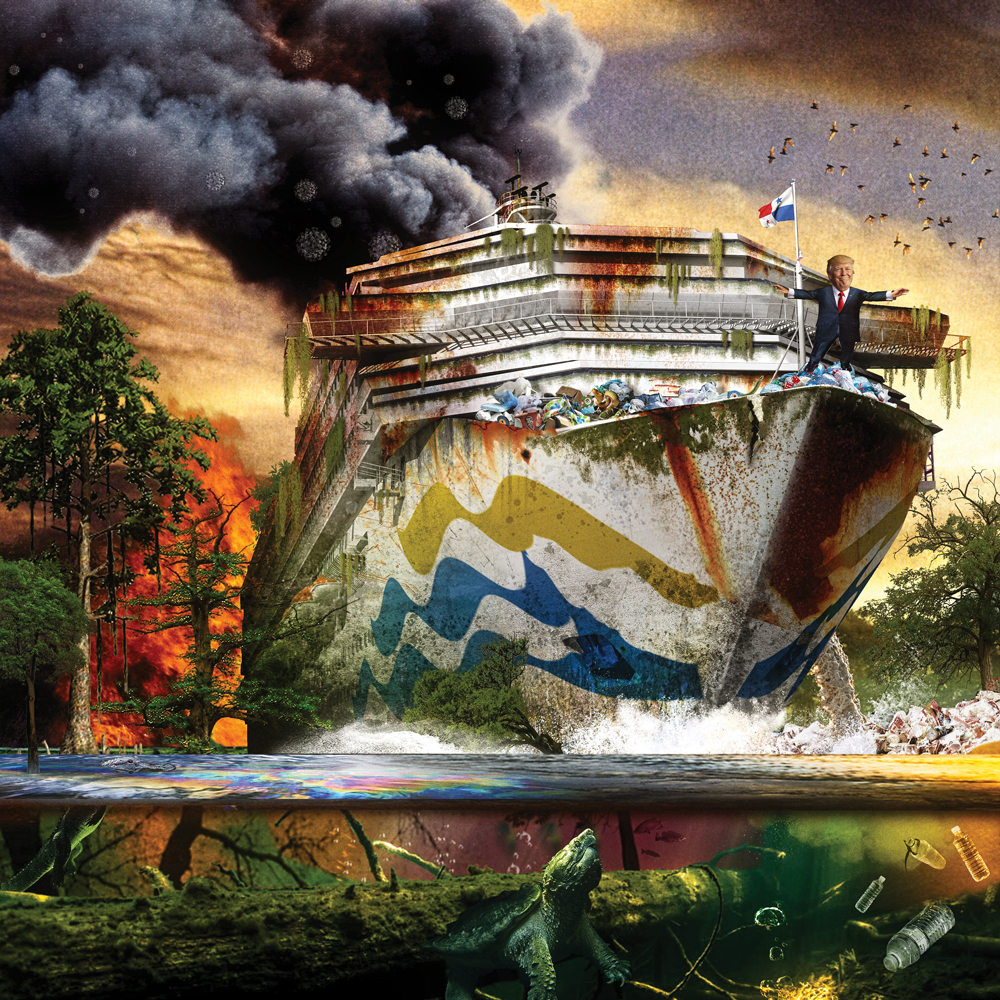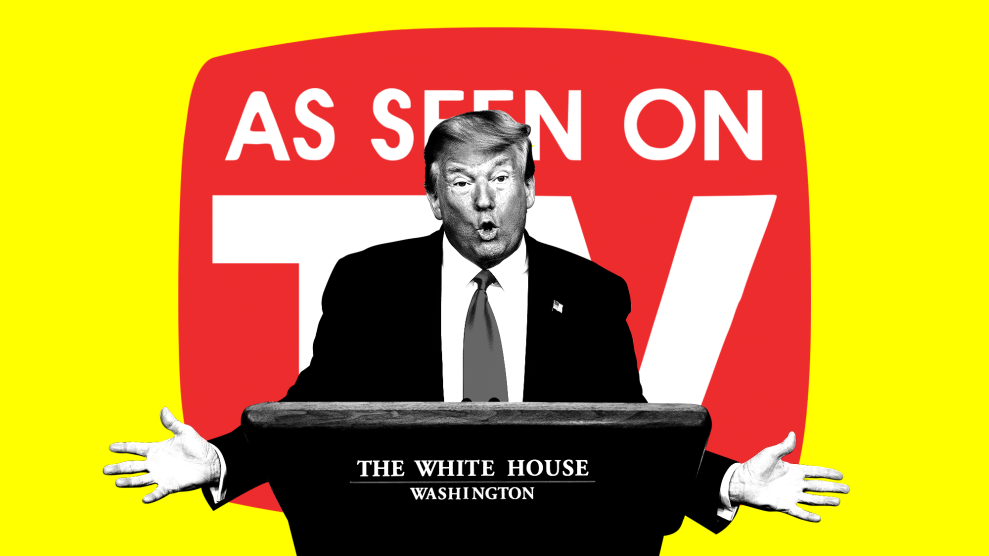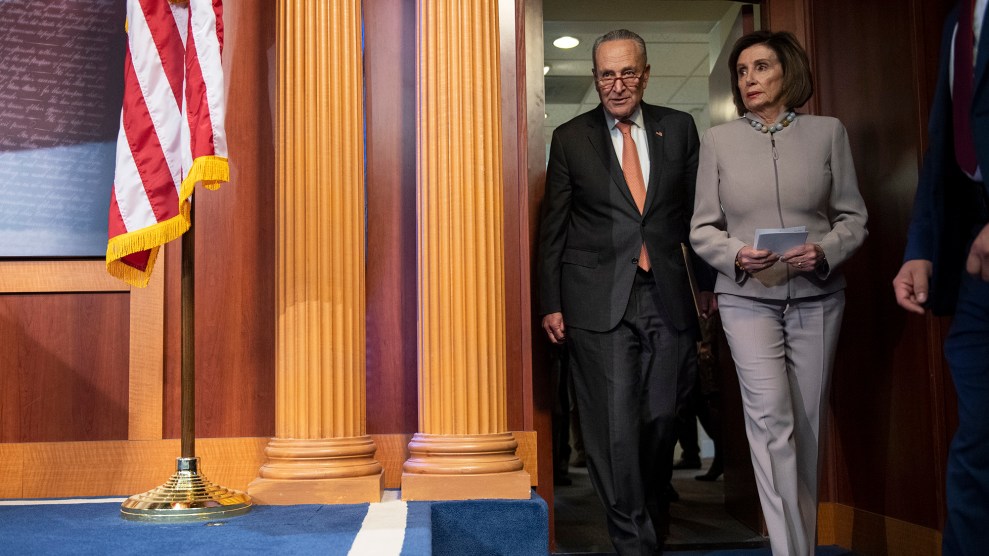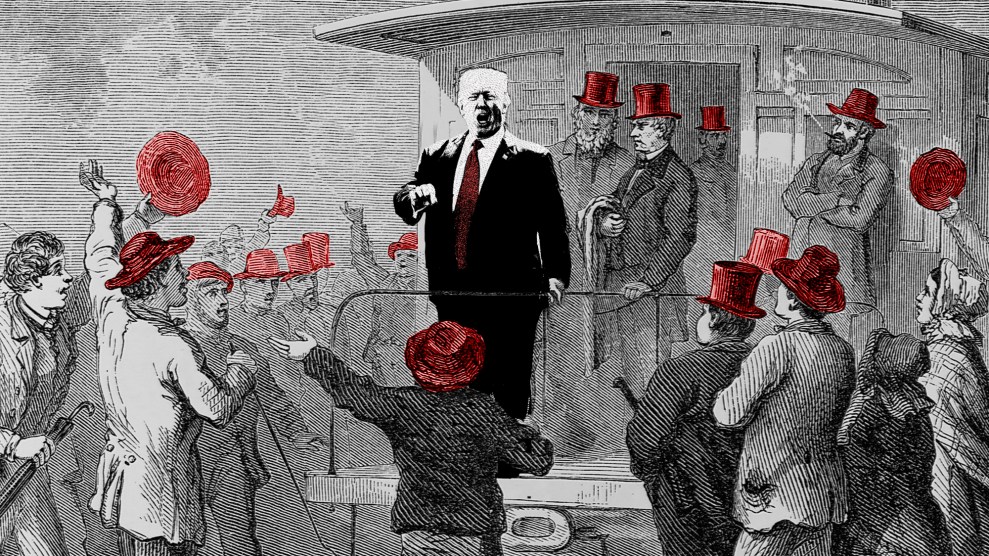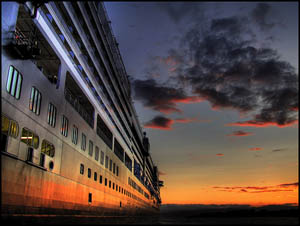If Donald Trump could build a city from scratch, it would have a casino and a golf course and all the cheeseburgers you could eat. The city’s residents would be old, with money to spend and nothing but free time. The workers would be poor, foreign, and always on the clock. They would literally live beneath you. There would be doctors, but not very many, and there would be cops, sort of, but who exactly they were there to protect and serve would remain ambiguous. There would be no proper government to speak of. The city and its services would be run by a corporation, and you would sign away your rights to a billionaire in his 70s with a tan and bad hair, in exchange for a promise of a good time—art auctions, live music, waterfalls of champagne. The city would pay no taxes but avail itself of the services funded by those who do.
It would look, in other words, a lot like the Carnival Corporation’s 18-story, 952-foot-long Diamond Princess as it entered Yokohama Bay in early February after a voyage through Southeast Asia for the Chinese New Year. Some people would find this city tacky. But it would be an altogether pleasant place for many people, much of the time. However, you would not want to be there during a pandemic.
As the cruise approached port, the coronavirus was confined almost entirely to the Chinese city of Wuhan. Trump’s top public health concern was vaping. But on February 1, a passenger who had disembarked from the Diamond Princess tested positive for the virus. Three days later, passengers quarantined. While customers took their meals in their cabins, the vessel’s crew—more than 1,000 people from 48 countries—continued to go about their work. The number of cases onboard would ultimately grow to 712, and 14 people would die. The ship, flying the flag of the United Kingdom and owned by a company—registered in Panama—that’s chaired by one of the richest men in Miami, saw the first major outbreak of COVID-19 outside of Wuhan.
The pandemic has penetrated nearly every corner of the globe. It has burned through nursing homes and choir practices. It has preyed on the elderly and the immunocompromised, people without access to reliable health care, and the young and perfectly healthy who never saw it coming. It’s killed more than 100,000 people in the United States in big cities and small towns. But for several weeks, before life as we know it shut down, you could turn on CNN and watch your own dismal future, adrift at sea.
After the Diamond Princess went into lockdown, the pattern played out on dozens of other cruise ships—sometimes weeks after it was clear that these vessels were sitting ducks. The Costa Luminosa (owned by Carnival subsidiary Costa Cruises) was waylaid off of France. The Grand Princess (owned by Princess Cruises—also Carnival) detoured to Oakland. The Zaandam (part of Holland America, a.k.a. Carnival) floated aimlessly for days while Florida’s governor debated whether he would accept its passengers.
Cruise ships are uniquely vulnerable when something goes awry—be it an outbreak, a navigation error, or a fire that knocks out the power system and fills the decks with raw sewage (google it). But the industry’s explosive growth and skyrocketing profits over the last 50 years have been driven, in part, by a freedom to circumvent health, labor, and safety requirements that bind companies back on shore. The industry, typified by Carnival’s billionaire chair, Micky Arison, has spent decades smoothing over bad experiences with booze and vouchers, insulating itself from the obligations of corporate citizenship in a maze of contracts and loopholes, and cultivating allies in Washington with free vacations and campaign cash. Long before the pandemic, cruise lines glided over sexual assaults, deaths, outbreaks, illegal dumping, and complaints of worker exploitation while hardly deviating from their course.
For more articles read aloud: download the Audm iPhone app.
The pandemic put that steel hull of invincibility to the test, placing Carnival and the other giants of the industry in the crosshairs of government watchdogs in multiple countries. The Centers for Disease Control and Prevention scolded cruise companies for their slow response. Australia launched an investigation into Carnival’s handling of the COVID-19-afflicted Ruby Princess. Lawsuits piled up. Congress hinted at hearings. Decadent, tax-avoiding, gas-guzzling, low-wage—the industry might have been headed for a reckoning in a different political environment. But the White House struck a different note. Trump treated the human victims of the virus with detachment, rarely acknowledging the toll it was taking on American families, and treating stranded passengers as little more than a nuisance that unfairly marred his sterling record. But in Carnival he seemed to find a victim he could empathize with.
The cruise industry as we know it—the round-trip voyage to nowhere, the booze, the buffets, the Apprentice-themed group packages—began in the early 1970s, when an immigrant from Israel got a good deal on a boat. The age of air travel was making big ocean liners obsolete, and Ted Arison, a second-generation shipping magnate, was fishing around Miami for the next big thing. With a businessman from Oslo, he co-founded what is now Norwegian Cruise Line, but they soon fell out. On the way out the door, Arison used the company’s funds to purchase a secondhand ship for himself. The vessel was called the Empress of Canada, but Arison wanted to convey good times, not grandeur. He renamed it the Mardi Gras. He called the new company Carnival. Like many corporate juggernauts—and Carnival would devour so many competitors that rivals would call it “Carnivore”—Carnival’s rise is shrouded in myth. As the story goes, on its maiden voyage, with hundreds of travel agents onboard, the Mardi Gras ran aground while it was still in sight of land. For 28 hours. Anxious to salvage the event, staff plied guests with free liquor. When it finally got going, the aging Mardi Gras had to creep along to conserve fuel. The idea was born: Carnival would be what Arison’s son and successor, Micky, called “the fun ship.” Instead of treating the cruise as a way of getting to a destination, the cruise would be the destination.
But the company’s success story is not just one of branding; it’s also the product of an elaborate legal scaffolding. Take the ships themselves. During World War II, the United States embraced flags of convenience to keep the flow of supplies going to Europe while nominally staying neutral. Ships that were American in all other ways could fly the colors of any nation that would have them. After the war, shipowners rushed to register their fleets in small countries that were happy to absolve these companies of corporate tax obligations, regulations, and oversight in return for a filing fee. The Diamond Princess, for example, flies the flag of the United Kingdom, but it’s owned by Princess Cruises, which is headquartered in Southern California and incorporated in Bermuda. Princess’ parent company, Carnival, a company so clearly ensconced in Miami that taxpayers helped fund a new cruise terminal for the company and a basketball arena (Micky Arison owns the Heat), is officially Panamanian. The itinerary of many cruises is even dictated by the need to preserve this system. US law prevents foreign-flagged ships from traveling directly between American ports, so as a workaround, a ship leaving Florida must visit at least one foreign destination before turning around.
Cruises surged in popularity because they are affordable for middle-class families and senior citizens but still offer luxury trappings. Foreign-registered companies can offer such prices because of how little they have to pay for anything else. While relying on the services of roughly 20 different federal agencies, Carnival saved $600 million last year by paying virtually no US corporate taxes. (The company points out that last year it paid more than $700 million in port fees and various federal, state, and local taxes.) But the offshoring of the business also boosted the industry’s bottom line in another big way—it allowed companies to skirt US labor laws.
Instead of adhering to American minimum wage, overtime, and safety standards, cruise lines simply have to abide by those of places like Liberia, Panama, and Bermuda, which take a hands-off approach to their corporate citizens. And the cruise companies aren’t afraid to play rough. When Honduran crew members organized a strike aboard two Carnival ships in Miami in 1981—upset about 12-hour days, sardine-like living conditions, and wages as low as $100 a week—Micky Arison hired a private security firm to get them off the ship. Vans of immigration agents stood by to deport them.
Cruise ships are crewed overwhelmingly by workers from countries like the Philippines and Indonesia. The companies argue that the wages on a cruise ship are considerably greater than those in the workers’ home countries. That’s true. But, for the hours workers put in, the take-home pay might add up to just a few bucks an hour. Workers who feel wronged by cruise companies are left with shockingly little recourse because contracts force cruise-ship employees into arbitration. Ross Klein, a Memorial University of Newfoundland sociologist whose cruise research cost him his press access to trade shows, told me that if a crew member from South Africa sought arbitration with Carnival, they would have to attend a hearing in Monaco—“and you’d have to share the cost of the arbitration with the employer,” he added. Try paying for all that on tips.
No one embodies the lengths the industry will go to in order to hold onto its money like the Arisons. For a long time, the elder Arison, a dual citizen of the United States and Israel, shielded his personal income from the IRS by reinvesting it in the company. After the IRS closed that loophole, the billionaire had the company reimburse him—in the form of a dividend—for whatever he happened to owe that year. Then, in 1990, Ted Arison renounced his American citizenship so that his estate would transfer to his children tax-free. He just needed to live another 10 years to qualify. He made it nine years and change.
There’s a famous story about how the cruise industry gets its way in Washington. Sometime in the early 1990s, Rep. Gene Taylor, then a Mississippi Democrat, was on his way to the House floor to vote on an amendment opposed by the industry when he encountered the cruise industry trade association’s lobbyist—a former congressional staffer. Taylor had fought the industry for years, repeatedly introducing legislation designed to bring maritime jobs back to American shores. The lobbyist had an idea on how to change his mind: a complimentary cruise—“so that you get to know us,” Taylor later recalled.
Taylor turned down the free vacation, but plenty of his colleagues didn’t. Alaska Rep. Don Young brought his wife (and two colleagues and their wives) on a 1987 cruise. Former Montana Sen. Max Baucus once took a four-day Caribbean vacation at sea (gratis), along with a five-day sojourn in South Florida, compliments of industry lobbyists. Members of Congress insisted these junkets were fact-finding expeditions. “I know this may not look great,” an unlucky staffer explained after one such story broke, “but it’s not like they spent the whole time playing shuffleboard.”
Shilling for Panamanian cruise companies isn’t exactly popular, but you don’t need a lot of friends in Washington if you just have the right ones. And no one has been friendlier to the foreign cruise industry than Young, who has represented Alaska’s at-large district since 1973. A snarling, bearded ex–tugboat operator who once brandished a walrus penis during a debate and pulled a knife on a speaker of the House, Young picks his fights—usually over money—and never backs down.
Cruises are the lifeblood of Alaskan tourism. About 5 percent of all global cruise traffic goes through the state, according to industry data. Communities along the state’s Inside Passage have long struggled to balance the economic boost of millions of sightseers with the environmental and political sacrifices that come with it. It has never been much of a dilemma, though, for Young, who has received more cruise industry campaign money over the years than any other member of Congress.
Young amended a Coast Guard appropriations bill in the 1990s to safeguard the industry from liability lawsuits. Critics argued the measure would make it harder for sexual assault victims to seek damages. The final bill blocked all claims of “emotional distress” and “mental suffering” unless caused by physical injury, but made exceptions for sexual misconduct. (When Congress was at an impasse, Arison traveled to Washington to make the industry’s case in person.) Young added an amendment to a different bill legalizing gambling on Alaskan cruises. An Alaska colleague got Bill Clinton’s secretary of the interior to expand the number of ships allowed into Glacier Bay National Park, but it was Young who, over the protests of the state’s small fleet of domestic cruise ships, tweaked yet another piece of legislation—as chair of the House Natural Resources Committee, it was no great feat—to give foreign cruise companies a monopoly on a lucrative cruise route through the park. (In 2019, Carnival paid a $20 million criminal penalty for doctoring ship logs to cover up illegal dumping in Glacier Bay and other waterways.)
“Cruise lines are a very powerful industry with a lot of sway in DC,” says Sen. Richard Blumenthal (D-Conn.), who has pushed legislation that would require new safety standards on ships. “They are a formidable foe.”
“They get to ’em—every time,” Jamie Barnett, president of the International Cruise Victims Association, an organization that lobbies for stricter safety regulations on cruise ships, says of her meetings with lawmakers on Capitol Hill. “We come in and we have pictures and stories and they listen—every one of them listen—but then the lobbyists for the [industry] come right behind us with their money and they forget about us.”
Despite the implication of the ICVA name, ships aren’t necessarily more dangerous than the mainland. But crime victims have far less recourse at sea than they might onshore. Victims report their crimes to private ship security. And although the industry has improved its reporting policies over the last decade, stories abound of victims being offered perks to keep quiet, or of crime scenes being cleaned up. By the time American authorities get involved—if they do—agencies in friendly foreign ports sometimes have had a first pass. Evidence gets lost. Culprits abscond. When an American woman sued Carnival in 1999 alleging she’d been raped by a crew member, the cruise line escorted its just-fired employee to the airport and out of the country before the FBI could interview him. (The company claimed there was a miscommunication.) In the course of that case, a Florida judge ordered the company to release statistics on how many sexual assaults had been committed by crew members over the previous five years. The answer: 108—including 22 alleged rapes. None of which were successfully prosecuted. The slow-burning scandal on HBO’s Succession—in which Logan Roy’s cruise division covered up years of sexual assaults and other crimes—wasn’t that far-fetched.
For a long time, the only people publicizing these cases were academics like Klein, the sociologist. Eventually, a law written by California Rep. Doris Matsui forced cruise lines to report statistics on violent crimes and suspicious deaths. In 2013, after a disastrous year that saw 32 people die aboard the wrecked Costa Concordia (run by a Carnival subsidiary) and the infamous “poop cruise” (when sewage flowed down the halls of the Carnival Triumph), the industry was dragged before Congress for hearings on shipboard safety and tax avoidance. But little came of the grilling, and companies have continued to resist safety measures such as a requirement to equip ships with motion sensor devices to alert crew when someone has fallen overboard.
Barnett, like many members of ICVA, was driven to activism by personal tragedy. In 2005, her 25-year-old daughter, Ashley, died suddenly onboard a ship from an overdose of methadone—a substance she says her daughter would not have knowingly taken. Barnett said the first phase of the investigation was handled by ship security; then the Mexican police took over. It was only once the cruise docked in the US that the FBI began to investigate. A century-old law called the Death on the High Seas Act sets the amount of damages a family can receive from an offshore wrongful death as equivalent to lost lifetime earnings, minus taxes and expenses. Cruise lines have successfully lobbied to keep the cap on the books, even helping BP shoot down an effort to secure money for the families of Deepwater Horizon victims. “My daughter, when she died, she didn’t support me,” Barnett says. “So her life was worth nothing.”
Ships have always been important nodes in the spread of contagion. The word “quarantine” comes from the 40 days that ships were required to sit tight in Italian ports during the Black Death. In 1918, the “Spanish” influenza was dispersed around the globe by American troop carriers. According to the CDC, there were 13,000 cases of norovirus (which is highly contagious, causing vomiting and diarrhea) on cruise ships plying US waters between 2008 and 2014 alone. Dr. Anthony Fauci may have been joking around when he said in March that “personally” he would never go on a cruise, but an epidemiologist writing for NBC News last August was not. “What I see when contemplating such an excursion,” she wrote, “is the potential to be trapped with thousands of others in a confined space, suffering from gastrointestinal ailments like norovirus and E. coli, respiratory infections including influenza and chickenpox, or as a recent Scientology cruise demonstrated, measles.” Scientology and measles. What’s not to love?
“A cruise ship is a small town—at least by Connecticut standards,” says Blumenthal, the Connecticut senator. But unlike a comparably sized place on the mainland, there’s no legal requirement for medical professionals onboard to be certified in the United States. Coronavirus screening aboard the Grand Princess and other vessels consisted of a simple questionnaire, not a medical evaluation. “The lack of proper medical care and facilities exacerbated the crisis and showed the American public very clearly and dramatically how abysmally inadequate health care on cruise ships can be,” he adds. (Carnival spokesperson Roger Frizzell said the company’s coronavirus protocols, which included a restriction on passengers who had been in China within the last two weeks, went “well beyond” comparable venues and noted the company’s on-ship medical facilities were “mandated and closely regulated by the CDC and other health authorities with strict oversight.”)
Blumenthal and Matsui have pushed legislation to raise the health care standards of ships five times, but it has never gotten out of committee. When Blumenthal has included variations of the bill in funding measures, another lawmaker blocked it. That would be Dan Sullivan, a Republican from cruise-friendly Alaska—the same senator who single-handedly saved the industry $70 million a year with a timely amendment to the 2017 tax reform law.
Despite the frequency with which ailments like norovirus afflict cruise passengers, the industry was ill-prepared for the inevitable outbreaks. In the case of the coronavirus pandemic, the result was a timeline that mirrored the slapdash federal response that was unfolding concurrently. The Costa Luminosa’s passengers were not notified for more than a week that an Italian man had been discharged ashore with COVID-19-like symptoms (he later died). When the ship finally docked in Marseille, nearly half of the 75 passengers tested were positive. (“It is easy to look backward, but we were relying on medical experts and the best information available at the time to make our decisions,” Frizzell said. “It is revisionist history to…suggest we should have acted any different than any others in the US at the time.”)
In a recent lawsuit, a woman whose husband died after contracting the virus aboard the Grand Princess recalled arguing with the ship’s staff as it stalled in responding to her requests for medical help. How did she know he really had a fever? they wanted to know. (Carnival said it does not comment on ongoing litigation.) Crew members on some ships—sometimes given paper napkins in lieu of PPE—had it even worse, as the living conditions and rigors of the job made distancing impossible. In a class-action lawsuit filed in April, Alexandra Nedeltcheva, a Bulgarian server on Royal Caribbean’s Celebrity Apex who contracted the virus, alleged that workers continued to eat from a buffet belowdecks and participated in mandatory drills more than a week after the company “acquired reason to suspect the presence of COVID-19” onboard. Two days after the ship held a party for crew members, seven of them tested positive. Onboard the Diamond Princess, 15 of the 20 crew members who tested positive were food service workers. Hundreds of workers would eventually fall ill on cruise ships, according to the Miami Herald.
On March 6, as the Grand Princess was quarantined off California, Trump told reporters he was keeping the ship offshore because he didn’t want its 21 active cases to count toward the national total. He seemed ready, on the other hand, to help the ships’ owners to terra firma. At a reelection fundraiser at his Mar-a-Lago retreat that night, the Washington Post reported, he promised a room of high-roller Republican donors that the cruise industry would stay open for business.
Of course Donald Trump and Micky Arison, chair of the world’s largest cruise company, are friends. It would almost be weird if they weren’t: two hospitality billionaires who inherited their fathers’ businesses and have a passion for tax avoidance and a flair for showmanship. They go way back. Trump attended a Heat game with Arison in 2005, the same year Carnival hosted an Apprentice-themed cruise. Carnival later sponsored a two-part finale of Celebrity Apprentice. The Washington Post reported that when Trump renovated his golf club in Doral, Florida, Arison sent him a congratulatory note. Trump has frequently singled out Arison for praise on Twitter.
Their circles have increasingly overlapped as Carnival’s business navigates Trump’s Washington swamp. Last year, to curry favor with Trump on trade policy, the company hired Pam Bondi, the former Florida attorney general and Trump associate, and Brian Ballard, one of the president’s biggest fundraisers, billed by Politico as “the most powerful lobbyist in Trump’s Washington.” (Bondi’s sister-in-law, Tandy Bondi, was already a Carnival lobbyist.) When Pam Bondi’s work was done, she joined Team Trump as an impeachment counsel. As Carnival’s stock plummeted this spring, it turned to Trump’s friend, Crown Prince Mohammed bin Salman of Saudi Arabia, who stabilized the free fall by purchasing 43.5 million shares in the company via the Gulf nation’s sovereign wealth fund.
Trump could not keep the cruise business open—under pressure from the CDC, the industry postponed all new cruises on March 13, the same day Trump declared a national emergency. But Arison and Trump spoke several times during the crisis. In mid-March he called the president to offer up his ships for use as hospitals. Carnival even volunteered its crews to continue cleaning the ships—all it asked was that the government cover “the essential costs of the ship’s operations while in port.” There was a familiar note to the offer—after Hurricane Katrina, FEMA gave Carnival a $236 million contract to provide floating lodging to relief workers, but the ships sat mostly empty for weeks. Trump plugged Carnival at his press conference later that day, saying, “It was a very generous offer” that he was taking under consideration, but he sent an actual Navy hospital ship to New York. Still, Arison’s offer put the company in the news for something positive, which might have been the point. The company’s stock briefly rallied. Trump showered the industry with attention, dispatching Pence to Tampa to meet with Arison and other cruise industry executives to discuss handling COVID-19 outbreaks. For a few weeks, he seemed to consider a cruise industry bailout. It was a “prime candidate” for a financial rescue, Trump said on March 18. “We can’t let the cruise lines go out of business,” he declared a few days later.
The cruise line rescue never gained traction in Congress, and the industry insisted it wasn’t asking for one. The final version of the CARES Act gave the Treasury secretary broad power to distribute funds, but only to companies based in the United States. When CNBC reported that the cruise lines were talking with a group of senators about a “legislative fix,” even some Republicans balked. “Come back to America,” tweeted Missouri Sen. Josh Hawley, “and pay your taxes.” Nick Ayers, Mike Pence’s former chief of staff, suggested they “go to where [their] ship flies her flag and ask them for help.” (Bermuda Premier David Burt told me no cruise companies had asked his government for financial assistance.)
Trump himself changed course after apparently learning that “our cruise industry” was not, in fact, ours. “They’re based in different places, I won’t tell you where—I could tell you exactly where they’re based, but I won’t do that, but they’re based in actually more than one place, as you know,” he said.
But in another sense, the cruise industry got what it needed. The Trump administration didn’t need to fund the ships directly because other aspects of the rescue package did the job for it. In Carnival’s case, it was the Federal Reserve’s decision to juice the credit market that allowed the company—which had gotten desperate enough to start negotiating with hedge funds—to secure a more hospitable loan through its friendly neighborhood banker, JP Morgan. The aid package may have left restaurants in limbo and furloughed workers struggling to make rent, but for larger corporations, the system worked—increased liquidity was enticing enough for investors to toss them a life raft. In early May, Norwegian announced that it was on the verge of bankruptcy. Within a day, though, it had cobbled together enough capital from investors to fund the company for 18 more months without revenue. The cruise giants aren’t totally in the clear, but when you have well-placed friends and make your money offshore, the fundamentals are always strong.
Shortly after signing the cruiseless bailout into law, Trump announced the members of his advisory council on reopening the economy. Among them were sports commissioners, restaurateurs, and bankers. And one Micky Arison, of Carnival Corp.
By the time passengers aboard the Diamond Princess and other ships finally returned home, life onshore increasingly resembled the purgatory they’d left behind. “The whole world feels like a cruise ship now,” one passenger mused to NBC News.
He meant that the whole world was in quarantine. But if the world felt like a cruise ship, it was also because, while many people were now in lockdown, many others were not allowed to be. The cruise ship outbreak was the American pandemic in miniature; the virus fed off the inequities and deficiencies of health, labor, and housing systems. Cruise ships, with their Parasite-like layering of workers and pleasure seekers, are like massive floating models of extreme inequality, of what a society looks like when its leaders cut the “social” out of the social contract.
Carnival maintains it acted appropriately, perhaps even nobly. “Each ship is a mini-city,” the company’s CEO, Arnold Donald, told Bloomberg two months after the Diamond debacle. Had it really acted so much differently than New York? But there wasn’t much time to worry about what went wrong. In May, as more than 100,000 crew members remained stuck onboard otherwise empty cruise ships in foreign ports, so desperate to return home that Royal Caribbean ship hands launched a hunger strike, Carnival announced some good news: Cruises would start up again, perhaps as early as August. Rooms start at just $298. Face masks not included.
